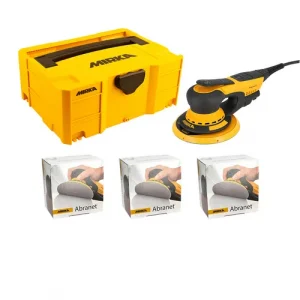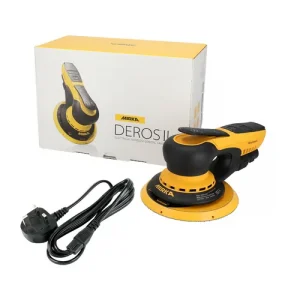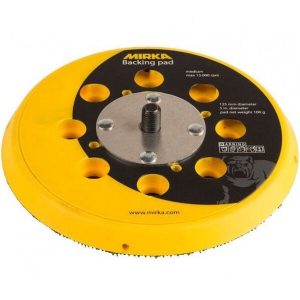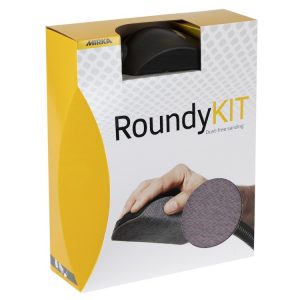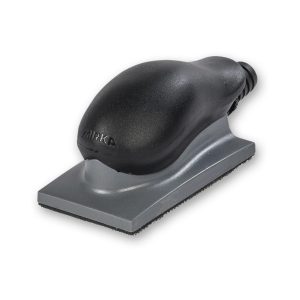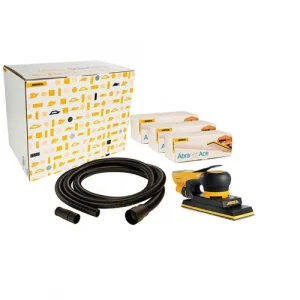Sander Machines
Sander machines are power tools used to smoothen and even out surfaces by the force of abrasion with sandpaper. Sanders can be used to smooth materials including wood and plastics, as they remove waste material. We have an excellent collection of sanding machines available here at Fosseway Tapes. Our sanding tools are suitable for both work purposes and domestic purposes, so whatever your requirements, we have got you covered.
Showing all 8 results
-
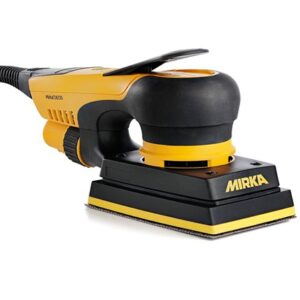
Mirka DEOS II 353 81x133mm 230V Orbit 3.0 With Case
£499.00 Inc. VAT Read more -

Mirka DEOS II 81x133mm 230V Deco Solution Kit
£525.00 Inc. VAT Add to basket -

Mirka DEROS II 125/150mm Deco Solution Kit – 230V (KIT2411CDMUK)
£520.00 Inc. VAT Read more -

MIRKA DEROS II 680CV 150mm 8,0 WITH UK CABLE
£580.00 Inc. VAT Add to basket -

Mirka Net Backing Pad 125mm – Hook & Loop, Dust-Free
£39.00 Inc. VAT Add to basket -

Mirka Roundy Kit – 150mm Hand Sanding Block & Discs
£48.90 Inc. VAT Add to basket -

Mirka Sanding Block for Abranet Strips 70mm x 125mm Mirka Code 8391402011
£18.99 Inc. VAT Add to basket -

Mirka® DEOS 383CV 70mm x198mm 230V Abranet ACE Solution
£510.00 Inc. VAT Read more
Electric Sanders
In our electric sanders range, you will find products manufactured by the famous Mirka brand so you can expect phenomenal performance and quality with every product. Browse our sander machines today to take advantage of the fantastic deals and prices on offer across our stock. Alternatively, get in touch with us if you have any questions or would like to find out further information regarding our orbit sanders.
Sanding is a necessary step in many woodworking and DIY projects, but it can be a time-consuming and tiring task when done manually. This is where sanding machines come in – they are designed to speed up the sanding process and provide a more consistent finish.
Types of Sanding Machines
There are lots of different types of sanders. These include:
Belt Sander
A belt sander is a powerful sanding machine that uses a continuous loop of sandpaper wrapped around two drums to sand large areas quickly. Belt sanders can be handheld or stationary, and they are ideal for sanding flat surfaces, such as floors, walls, and tabletops.
Orbital Sander
An orbital sander is a handheld sanding machine that uses a circular motion to sand the surface. Orbital sanders are smaller and more lightweight than belt sanders, making them easier to maneuver. They are suitable for sanding small or curved surfaces, such as furniture or car bodywork.
Random Orbital Sander
A random orbital sander is similar to an orbital sander, but it uses a circular motion combined with a random orbital pattern to reduce the risk of swirl marks. Random orbital sanders are versatile and can be used for a range of tasks, from sanding flat surfaces to removing paint or varnish.
Drum Sander
A drum sander is a stationary sanding machine that uses a rotating drum to sand large areas of wood flooring or other flat surfaces. Drum sanders are powerful and can remove a lot of material quickly, but they require a high level of skill to use properly.
Can sanding machines be used for wet sanding?
Some sanding machines, such as wet sanders or wet/dry sanders, are designed to be used with water or other liquids for wet sanding. However, not all sanding machines are suitable for wet sanding, so it’s important to check the manufacturer’s instructions before use.
Can sanding machines be used for sanding curved surfaces?
Yes, sanding machines such as orbital sanders or random orbital sanders are suitable for sanding curved surfaces. It’s important to choose the appropriate sandpaper grit and to use a light touch to avoid damaging the material.
How do I maintain my sanding machine?
It’s important to clean your sanding machine after each use to remove dust and debris. Additionally, you should check and replace the sandpaper as needed and periodically check the machine’s motor and parts for signs of wear or damage.
Can sanding machines be used for finishing work?
Sanding machines can be used for finishing work, but it’s important to use the appropriate grit sandpaper and to sand in a controlled manner to avoid removing too much material.
How do I choose the right sanding machine for my project?
When choosing a sanding machine, consider the type of material you’ll be sanding, the size and shape of the surface, and the level of detail required. Belt sanders are best for large, flat surfaces, while orbital sanders are better for smaller, curved surfaces. Random orbital sanders offer versatility for a range of tasks.
Can sanding machines be used for removing paint or varnish?
Yes, sanding machines can be used for removing paint or varnish from wood or metal surfaces. However, it’s important to use the appropriate grit sandpaper and to take care not to remove too much material. For removing paint or varnish from larger surfaces, a belt sander or random orbital sander may be more efficient.
Can sanding machines be used for both wood and metal surfaces?
Yes, sanding machines can be used for both wood and metal surfaces. However, it’s important to use the appropriate sandpaper grit and machine settings for each type of material.
Do I need to wear protective gear when using a sanding machine?
Yes, it’s recommended to wear protective gear such as goggles, a mask, and ear protection when using a sanding machine. This will protect you from dust, debris, and noise.
Can sanding machines be used to remove deep scratches from wood surfaces?
Yes, sanding machines can be used to remove deep scratches from wood surfaces. However, it’s important to use the appropriate grit sandpaper and take care not to remove too much material.
How often should I change the sandpaper on my sanding machine?
The frequency of changing sandpaper depends on the type of project and the amount of use. It’s important to change the sandpaper when it becomes clogged or worn to ensure a consistent finish.
Can sanding machines be used to polish surfaces?
Some sanding machines, such as random orbital sanders, can be used to polish surfaces. However, it’s important to use the appropriate polishing pads and compounds for the type of surface being polished.
Do I need to have previous experience to use a sanding machine?
It’s recommended to have some previous experience with woodworking or DIY projects before using a sanding machine. Additionally, it’s important to read the manufacturer’s instructions and follow safety guidelines to avoid injury or damage to the material being sanded.
Uses of Sanding Machines
Sanding machines are used in a wide range of woodworking and DIY projects, including:
Sanding wood floors
Sanding machines are commonly used to remove old finish or stain from wood floors, as well as to level out uneven areas.
Sanding furniture
Sanding machines can be used to prepare furniture for painting or staining, as well as to remove old paint or varnish.
Sanding drywall
Sanding machines can be used to smooth out rough patches or seams in drywall, as well as to remove old wallpaper or paint.
Sanding metal
Sanding machines can be used to remove rust or paint from metal surfaces, as well as to smooth out rough edges or surfaces.
Benefits of Sanding Machines
Sanding machines has many benefits. These include:
Time-saving
Sanding machines are much faster than sanding by hand, which can save a lot of time and effort on large projects.
Consistent finish
Sanding machines provide a more consistent finish than sanding by hand, as they can apply the same amount of pressure and sand at a consistent speed.
Reduced fatigue
Sanding machines can reduce fatigue and strain on the arms and hands, making them ideal for large or repetitive sanding tasks.
Versatility
Sanding machines are versatile and can be used for a range of tasks, from sanding wood floors to smoothing out metal surfaces.



